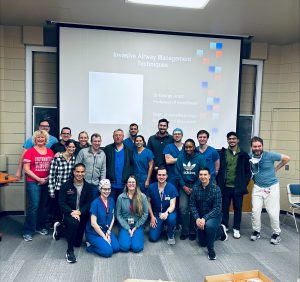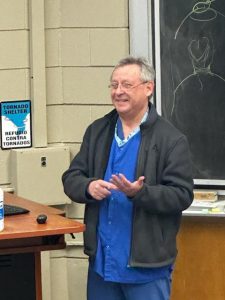
In an era of videolarngoscopes and extraglottic airway devices, the need for invasive airway management has become a rare event. The National Audit Projects 4 (NAP4) determined that invasive airway management was required in only 1:50,000 cases. However, when the clinical scenario and ASA Difficult Airway Algorithm dictate that invasive front of neck airway access is required, it is important that residents have experience with equipment and techniques that might ultimately result in vast improvements in clinical outcomes. These techniques include retrograde intubations, percutaneous and scalpel-based cricothyrotomy, and ultrasound assessment of upper airway anatomy.
Fortunately, the University of Wisconsin Department of Anesthesiology has a long-term commitment to airway excellence and has a bevy of committed anesthesiologists who strive to enhance resident airway education. Teaching the most recent airway course was Dr. George Arndt, who many will know as the inventor of the Arndt Endobronchial Blocker and the Arndt Airway Exchange Catheter Kit. Each of these inventions is known throughout the world, and their impact on the practice of anesthesiology and improvements in airway management safety is difficult to quantify.

The impact of Dr. Arndt locally is impossible to overstate, and his homegrown roots run deep. After growing up in Milwaukee, Dr. Arndt pursued undergraduate training at the University of Wisconsin–Eau Claire and medical school training at the University of Wisconsin–Madison, School of Medicine and Public Health. Dr. Arndt has 35 years of faculty experience in the practice of anesthesiology at the University of Wisconsin and is responsible for training countless anesthesiology residents, anesthetists, and medical students. His humor and approach to education ensure that content remains accessible and that learners are well prepared to address emergency scenarios in the future.

Recently, Dr. Arndt provided training in emergency airway management in an event hosted at the University of Wisconsin School of Veterinary Medicine on December 19 from 5 to 7 p.m. Coordinating the event were the Department of Anesthesiology’s Resident Program Director Eric Simon and Assistant Resident Program Director Dr. Patrick Meyer, who also provided assistance in wet lab education. The important task of event-space coordination and wet-lab material access was coordinated by Dr. Carrie Schroeder, DVM, who is a two-time recipient of a teaching distinction from the University of Wisconsin Department of Anesthesiology. This course consisted of didactic material provided by Dr. George Arndt and was followed by opportunities to practice important skills related to emergency invasive airway management. In addition, the residents were afforded the opportunity to practice ultrasound airway assessments and consider how this technology might be used to predict difficulty with airway management and guide airway topicalization efforts.
This workshop is an annual event and serves to complement the outstanding work done throughout the year by faculty educators.